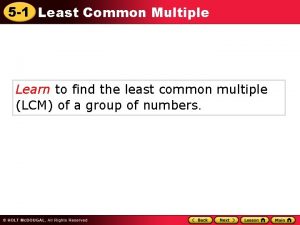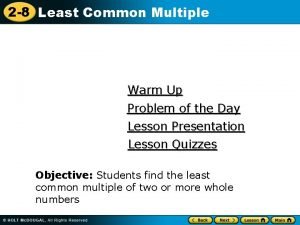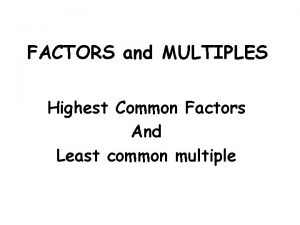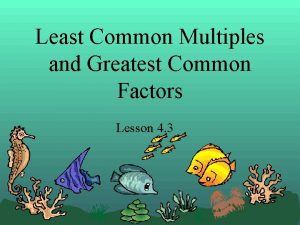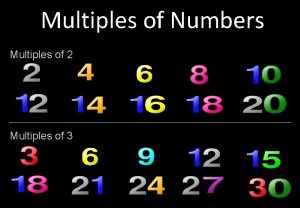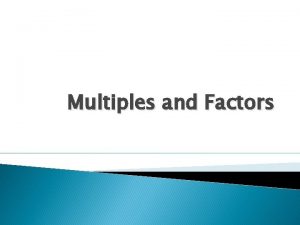FACTORS and MULTIPLES Highest Common Factors And Least









- Slides: 9

FACTORS and MULTIPLES Highest Common Factors And Least common multiple

Factor A factor of a given number is every number that divides exactly into that number. Example : Write down all factors of 15. 15 = 3· 5, so numbers 3 and 5 are factors of 15. Also 15 = 15 x 1, so 15 and 1 are factors of 15. The factors of 15 are 1, 3, 5, 15. NOTE: Number 1 and the number itself are always factors of any number.

PRIME AND COMPOSITE NUMBERS. • • • A PRIME NUMBER has exactly 2 factors, the number itself and 1. In other words, the prime number can be divided only by 1 and by itself. Note: 0 and 1 are not prime numbers. EXAMPLES ü 5 is a prime number, because the only factors it has are 1 and 5. ü Find all prime factors of 30. Solution: All the factors of 30 are 30, 15, 10, 6, 5, 3, 2, 1 But only 5, 3 and 2 are prime numbers. So, all prime factors of 30 are 2, 3 and 5. A COMPOSITE NUMBER has at least one more factor that the number itself or 1. In fact, all whole numbers that are not prime are composite except for 1 and 0, which are not prime and not composite.

DIVISIBILITY RULES The simple divisibility rules will help you to find factors of a number. The number is divisible by: • 2 if the last digit is 0, 2, 4, 6, or 8 • 3 • 5 • 6 example: 12346 if the sum of digits in the number are divisible by 3. example: 1236, because 1+2+3+6 = 12 = 3 · 4 if the last digit is 0 or 5. example: 178965 or 40980 if it is divisible by 2 and 3; • 10 if the last digit is 0. example: 99990 NOTE: If a number is divisible by 2 factors, it is also divisible by the product of these factors. Example : Number 18 is divisible by 2 and 3, so it must be divisible by 2 · 3 = 6.

prime factors of a number • Finding all prime factors of number “a”: We will start with the smallest prime number and we will divide a into it if we can. We will do the same with the result (or quotient), and we will keep dividing by prime numbers until we have 1 as a quotient. Each time we write the prime factor to the right and the quotient below: • Example: Prime factors of 24 24|2 12|2 6|2 3|3 1 So 24=2· 2· 2· 3 2 is a factor of 24; 2 is a factor of 12; 2 is a factor of 6; 3 is a factor of 3;

COMMON FACTORS When some numbers have the same factor, that factor is called a Common Factor. Example: Find all the common factors of 12 and 30. Factors of 12 are 1, 2, 3, 4, 6, 12. Factors of 30 are 1, 2, 3, 5, 6, 10, 30. The common factors of 12 and 30 are 1, 2, 3 and 6.

HIGHEST COMMON FACTOR (H. C. F). Máximo Común Divisor (M. C. D. ) To find the Highest Common Factor you can use the following method: • – Find all prime factors of both numbers. – Write the numbers as a multiplication of prime numbers. – Find which factors are repeating in both numbers and multiply them to get H. C. F Example: Find the Highest Common Factor (H. C. F. ) of 24 and 54. Solution: Finding all prime factors of 24 and 54 24|2 2 is a factor of 24; 54|2 2 is a factor of 54 12|2 6|2 3|3 1 24=2· 2· 2· 3 54=2· 3· 3· 3 2 is a factor of 12; 2 is a factor of 6; 3 is a factor of 3; 27|3 9|3 3|3 1| 3 is a factor of 27 3 is a factor of 9 3 is a factor of 3 Highest Common Factor MCD(24, 54)=2· 3=6

MULTIPLES. COMMON MULTIPLES • When you multiply a given whole number by any other whole number, the result is a MULTIPLE of that number. For example, 3 is the first multiple of 3(because 3· 1 = 3), 6 is the second multiple of 3, and so on. EXAMPLES ü Write down the first 3 multiples of 9. Solution: 9· 1 =9, 9· 2 = 18, 9· 3 = 27 So the first 3 multiples of 9 are 9, 18, 27. ü Write down all multiples of 3 greater than 10 but smaller than 20. Solution: Multiples of 3 are 3, 6, 9, 12, 15, 18, 21, 24, . . . The desired ones are 12, 15, 18. • The common multiples of two numbers are multiples of both numbers. Example: Find common multiples of 4 and 5. Solution: Multiples of 4 are 4, 8, 12, 16, 20, 24, 28, 32, 36, 40, . . . Multiples of 5 are 5, 10, 15, 20, 25, 30, 35, 40, . . . Common multiples of 4 and 5 are 20, 40, . . .

LOWEST COMMON MULTIPLE (L. C. M. ). mínimo común múlitiplo (m. c. m. ) The LOWEST COMMON MULTIPLE (L. C. M) is the smallest number that is a common multiple of two or more numbers. To Find L. C. M. we should do: -Find all the prime factors of both numbers. -Multiply all the prime factors of the larger number by those prime factors of the smaller number that are not already included. Example: Find the Lowest Common Multiple (L. C. M. ) of 24 and 54. 24|2 12|2 6|2 3|3 1 24=2· 2· 2· 3 54=2· 3· 3· 3 2 is a factor of 24; 2 is a factor of 12; 2 is a factor of 6; 3 is a factor of 3; 54|2 27|3 9|3 3|3 1| 2 is a factor of 54 3 is a factor of 27 3 is a factor of 9 3 is a factor of 3 So, the L. C. M. is 2· 3· 3· 3· 2· 2=216
 What are the factors for 54
What are the factors for 54 Highest common factors and lowest common multiples
Highest common factors and lowest common multiples Factor tree of 28
Factor tree of 28 Factors of 60 and 48
Factors of 60 and 48 Greatest common factor and least common factor
Greatest common factor and least common factor Lesson 2-1 greatest common factor
Lesson 2-1 greatest common factor Common multiples of 8 and 6
Common multiples of 8 and 6 Common multiples of 8 and 16
Common multiples of 8 and 16 How to find the least common multiple
How to find the least common multiple What is the lcm of 7 and 14
What is the lcm of 7 and 14








